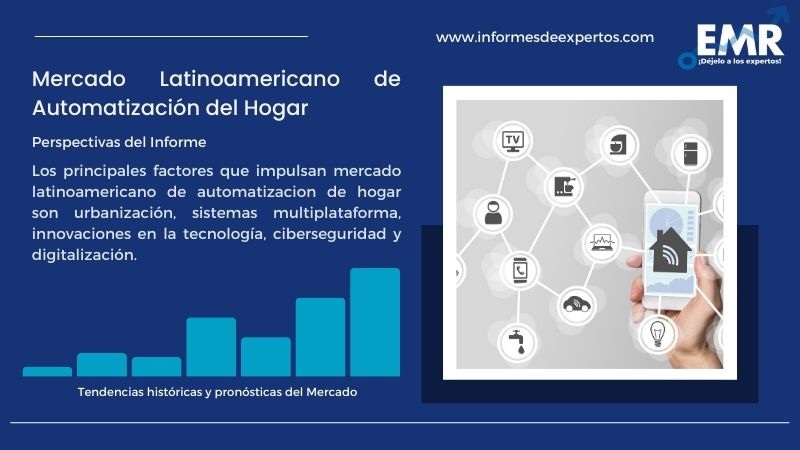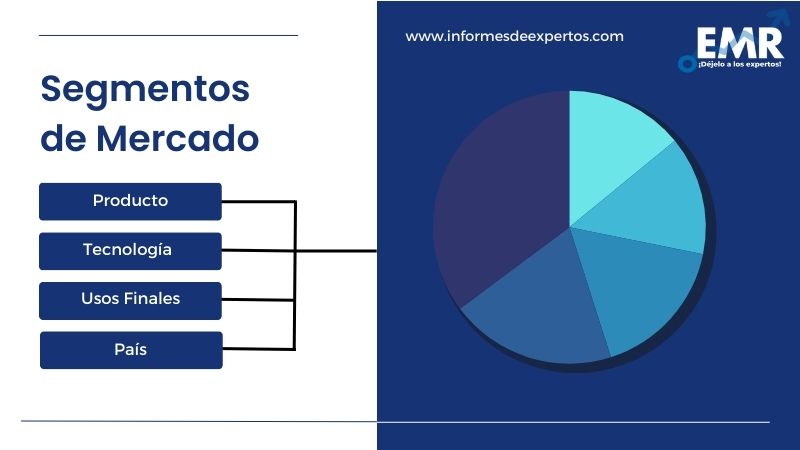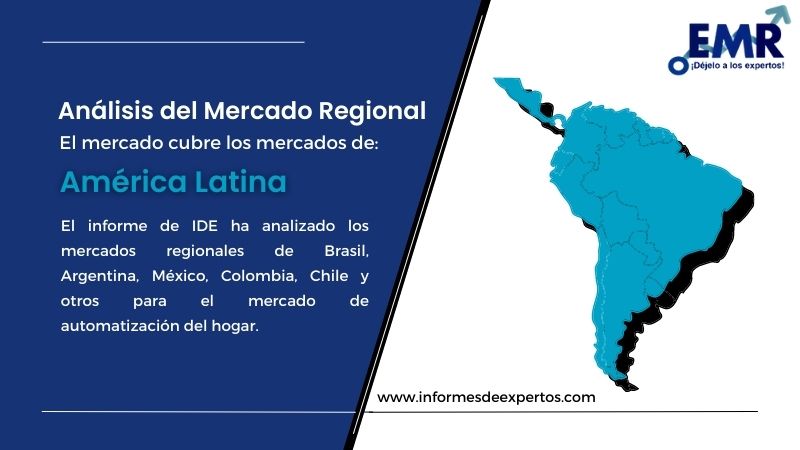Informes

Mercado Latinoamericano de Automatización del Hogar-Por Producto (Iluminación, Entretenimiento, HVAC, Seguridad y Protección, Otros); Por Tecnología (Por Cable, Inalámbrica); Por Usos Finales (Comercial, Residencial); Por País (Brasil, Argentina, México, Colombia, Chile, Otros); Dinámica del Mercado y Panorama Competitivo
Perspectiva del Mercado Latinoamericano de Automatización del Hogar
En 2025, el mercado latinoamericano de automatización del hogar alcanzó un valor aproximado de USD 5,38 mil millones. Se calcula que el mercado crecerá a una tasa anual compuesta del 8,7% entre 2026 y 2035, para alcanzar un valor de 11,39 mil millones de USD en 2035.

La automatización del hogar se refiere a la gestión de las funciones y actividades de la casa mediante un control automático y eléctrico. Esta automatización flexible y cómoda del control de los electrodomésticos y dispositivos del hogar permite una mayor eficiencia energética y una mejor gestión. Las principales aplicaciones del control remoto de los servicios del hogar son el control de la iluminación, los electrodomésticos de la cocina, la climatización, el riego del césped exterior y los sistemas de seguridad.
El mercado latinoamericano de automatización del hogar está preparado para crecer debido a los dinámicos patrones de consumo y a la mayor inclinación de las nuevas generaciones hacia la automatización de aparatos y servicios en el hogar. Además, la generación de ingresos promedio en el año 2020 y 2021 muestra un fuerte aumento en la demanda de automatización del hogar. Los ingresos que registró el mercado del hogar inteligente en el año 2021 fueron de 3.4 mil millones de dólares. Añadiendo a esto, se prevé que crezca a una tasa de crecimiento anual compuesta del 14,1% durante el período de pronóstico (2026-2035), por lo tanto, ampliando el tamaño del mercado de automatización del hogar.
Incluso, el COVID ha sido un importante indicador de crecimiento en el rendimiento del mercado de automatización doméstica. Debido a los protocolos del gobierno y los toques de queda, la resistencia del mercado mostró un exceso de penetración de Internet con el efecto de que las almas digitales se introdujeron para evitar el aislamiento. Así, la cuota de mercado de automatización del hogar y de los electrodomésticos inteligentes aumentó, especialmente en América Latina, donde el 67% de la población es usuaria activa de internet.
Los factores y tendencias que influyen en el mercado de automatización doméstica de manera positiva a un ritmo progresivo junto con ganancias rentables son la urbanización, las innovaciones en la tecnología, los sistemas multiplataforma, la ciberseguridad, el aumento de la renta disponible, la digitalización y otros. La necesidad sostenible de ahorrar energía y utilizarla de forma eficiente ha cambiado la forma de optar por los bienes y servicios de los consumidores. Además, la introducción de sistemas de seguridad rentables, ecológicos y residenciales se está integrando mediante tecnologías avanzadas para cambiar las perspectivas del mercado de automatización del hogar.
Automatización del Hogar: Segmentación del Mercado

En función del producto, el mercado puede dividirse en los siguientes:
- Iluminación
- Entretenimiento
- Seguridad y Protección
- Otros
Estos sistemas utilizan diferentes tecnologías como:
- Por Cable
- Inalámbrica
Por usos finales, el mercado se segmenta en:
- Comercial
- Residencial
El informe de IDE ha analizado los mercados regionales de Brasil, Argentina, México, Colombia, Chile y otros para el mercado de automatización del hogar.

La gestión remota del hogar impulsa el mercado latinoamericano de automatización del hogar
El mercado latinoamericano de automatización del hogar está ampliando su funcionalidad mediante la reforma de los métodos tradicionales de gestión y control de las características del hogar, servicios públicos y dispositivos. Los desarrolladores han introducido tecnologías como los sistemas multiplataforma y la integración de dispositivos inteligentes para facilitar los esfuerzos y la utilización eficiente de los recursos con el fin de mantener la sostenibilidad. Además, el incremento de la concienciación sobre la seguridad del hogar y el aumento de la población activa impulsan la demanda de sistemas de automatización del hogar, ya que disponen de funciones como la supervisión remota y los sensores de movimiento, entre otras, que garantizan la seguridad de los niños y los hogares.
La ciberseguridad es el principal factor que impulsa el crecimiento del mercado de la automatización del hogar. Las regiones latinoamericanas tienen la mayor cuota de usuarios activos de Internet, lo que significa la alta prevalencia de la vida digital debido a la digitalización y la urbanización, junto con las amenazas a la privacidad y la protección de los dispositivos de automatización del hogar. Este factor está impulsando a los consumidores a supervisar las actividades de Internet en sus hogares y ejecutar los arreglos posteriores a través de dispositivos domésticos inteligentes conectados a sus sistemas de automatización del hogar.
Actores Clave del Mercado Latinoamericano de Automatización del Hogar
Algunos de los principales actores mundiales son Google LLC, ABB Ltd., Honeywell International Inc., Legrand Group, Schneider Electric SE, Logitech International S.A., Nice Group, LG Electronics, Koninklijke Philips N.V. y Siemens AG entre otros.
Las bases de datos incluidas en el informe sobre el mercado latinoamericano de automatización del hogar proporcionan importantes impactos en el desarrollo presentadas por las principales empresas, teniendo en cuenta sus ingresos. Este informe consta de los valores del período histórico (2019-2025) y del período de pronóstico (2026-2035) con patrones de evaluación ampliados que se llevan a cabo mediante el análisis IDE basado en producto, tecnología, uso final y país del mercado para determinar el movimiento del estudio.
Además, el proyecto estudiado y analizado se basa en información detallada sobre el modelo de las cinco fuerzas de Porter, las estrategias de los principales actores existentes y sus carteras con diferenciación beneficiosa en innovación de productos en la industria. Por lo tanto, se concluye que el análisis del poder de negociación de los compradores, el poder adquisitivo de los consumidores, la amenaza de los sustitutos y la nueva entrada con el efecto de la reactivación económica y el desarrollo se evalúa para subrayar el poderoso impacto en el mercado.
Preguntas Clave Respondidas en Este Informe:
- ¿Cuál es el rendimiento actual y la trayectoria proyectada del mercado latinoamericano de automatización del hogar?
- ¿Cuáles son los principales impulsores, oportunidades y retos para el mercado latinoamericano de automatización del hogar?
- ¿Cómo afecta cada impulsor, restricción y oportunidad al mercado latinoamericano de automatización del hogar?
- ¿Cuáles son los principales mercados regionales estudiados en el informe?
- ¿Cuál es la región líder en el mercado latinoamericano de automatización del hogar?
- ¿Qué factores contribuyen al dominio de esta región en el mercado latinoamericano de automatización del hogar?
- ¿Cuál es la tasa de crecimiento histórica del mercado latinoamericano de automatización del hogar en los últimos años?
- ¿Cuáles son sus respectivas fortalezas y enfoques de mercado?
- ¿Cómo contribuyen estas empresas a la dinámica general del mercado latinoamericano de automatización del hogar?
- ¿Cuál es la estructura competitiva del mercado?
- ¿Quiénes son los principales actores del mercado latinoamericano de automatización del hogar?
Beneficios Clave para las Partes Interesadas:
- El informe de la industria de IDE ofrece un análisis cuantitativo exhaustivo de varios segmentos del mercado, las tendencias históricas y actuales del mercado, las previsiones del mercado y la dinámica del mercado latinoamericano de automatización del hogar de 2019 a 2035.
- El informe ofrece los datos más recientes sobre los impulsores, retos y oportunidades del mercado. El informe traza los principales mercados regionales, así como los que registran la tasa de crecimiento más rápida. Además, permite a las partes interesadas identificar los principales mercados nacionales de cada región.
- El análisis de las cinco fuerzas de Porter ayuda a las partes interesadas a evaluar el impacto de los nuevos operadores, la rivalidad competitiva, el poder del proveedor, el poder del comprador y la amenaza de sustitución. Ayuda a las partes interesadas a analizar el nivel de competencia en la industria de latinoamericano de automatización del hogar y su atractivo.
- El panorama competitivo permite a las partes interesadas comprender su entorno competitivo y ofrece una visión de las posiciones actuales de los principales actores del mercado.
Alcance del Mercado:
|
Características del Informe |
Detalles |
|
Año Base de la Estimación: |
2025 |
|
Datos Históricos: |
2019-2025 |
|
Datos de Pronóstico: |
2026-2035 |
|
Alcance del Informe: |
Tendencias Históricas y Previsiones del Mercado, Impulsores y Limitantes de
|
|
Desglose por Producto: |
|
|
Desglose por Tecnología: |
|
|
Desglose por Usos Finales: |
|
|
Desglose por País: |
|
|
Dinámica del Mercado: |
|
|
Panorama Competitivo: |
|
|
Empresas Cubrietas: |
|
*En Informes de Expertos siempre nos esforzamos por brindarle la información más reciente. Los números de artículo son solo indicativos y pueden diferir del informe real.
Language of the Report – English
Sin embargo, el informe puede estar disponible en español por un costo adicional.
1 Preface
2 Report Coverage – Key Segmentation and Scope
3 Report Description
3.1 Market Definition and Outlook
3.2 Properties and Applications
3.3 Market Analysis
3.4 Key Market Players
4 Key Assumptions
5 Executive Summary
5.1 Overview
5.2 Key Drivers
5.3 Key Developments
5.4 Competitive Structure
5.5 Key Industrial Trends
6 Market Snapshot
7 Opportunities and Challenges in the Market
8 Latin America Home Automation Market Analysis
8.1 Key Industry Highlights
8.2 Latin America Home Automation Historical Market (2019-2025)
8.3 Latin America Home Automation Market Forecast (2026-2035)
8.4 Latin America Home Automation Market by Product
8.4.1 Lighting
8.4.1.1 Market Share
8.4.1.2 Historical Trend (2019-2025)
8.4.1.3 Forecast Trend (2026-2035)
8.4.2 Entertainment
8.4.2.1 Market Share
8.4.2.2 Historical Trend (2019-2025)
8.4.2.3 Forecast Trend (2026-2035)
8.4.3 HVAC
8.4.3.1 Market Share
8.4.3.2 Historical Trend (2019-2025)
8.4.3.3 Forecast Trend (2026-2035)
8.4.4 Safety and Security
8.4.4.1 Market Share
8.4.4.2 Historical Trend (2019-2025)
8.4.4.3 Forecast Trend (2026-2035)
8.4.5 Others
8.5 Latin America Home Automation Market by Technology
8.5.1 Wired
8.5.1.1 Market Share
8.5.1.2 Historical Trend (2019-2025)
8.5.1.3 Forecast Trend (2026-2035)
8.5.2 Wireless
8.5.2.1 Market Share
8.5.2.2 Historical Trend (2019-2025)
8.5.2.3 Forecast Trend (2026-2035)
8.6 Latin America Home Automation Market by End Use
8.6.1 Commercial
8.6.1.1 Market Share
8.6.1.2 Historical Trend (2019-2025)
8.6.1.3 Forecast Trend (2026-2035)
8.6.2 Residential
8.6.2.1 Market Share
8.6.2.2 Historical Trend (2019-2025)
8.6.2.3 Forecast Trend (2026-2035)
8.7 Latin America Home Automation Market by Country
8.7.1 Market Share
8.7.1.1 Brazil
8.7.1.2 Argentina
8.7.1.3 Mexico
8.7.1.4 Colombia
8.7.1.5 Chile
8.7.1.6 Others
9 Regional Analysis
9.1 Brazil
9.1.1 Historical Trend (2019-2025)
9.1.2 Forecast Trend (2026-2035)
9.2 Argentina
9.2.1 Historical Trend (2019-2025)
9.2.2 Forecast Trend (2026-2035)
9.3 Mexico
9.3.1 Historical Trend (2019-2025)
9.3.2 Forecast Trend (2026-2035)
9.4 Colombia
9.4.1 Historical Trend (2019-2025)
9.4.2 Forecast Trend (2026-2035)
9.5 Chile
9.5.1 Historical Trend (2019-2025)
9.5.2 Forecast Trend (2026-2035)
10 Market Dynamics
10.1 SWOT Analysis
10.1.1 Strengths
10.1.2 Weaknesses
10.1.3 Opportunities
10.1.4 Threats
10.2 Porter’s Five Forces Analysis
10.2.1 Supplier’s Power
10.2.2 Buyers Powers
10.2.3 Threat of New Entrants
10.2.4 Degree of Rivalry
10.2.5 Threat of Substitutes
10.3 Key Indicators for Demand
10.4 Key Indicators for Price
11 Competitive Landscape
11.1 Market Structure
11.2 Key Company Profiles
11.2.1 Google LLC
11.2.1.1 Company Overview
11.2.1.2 Product Portfolio
11.2.1.3 Demographic Reach and Achievements
11.2.1.4 Certifications
11.2.2 ABB Ltd.
11.2.2.1 Company Overview
11.2.2.2 Product Portfolio
11.2.2.3 Demographic Reach and Achievements
11.2.2.4 Certifications
11.2.3 Honeywell International Inc.
11.2.3.1 Company Overview
11.2.3.2 Product Portfolio
11.2.3.3 Demographic Reach and Achievements
11.2.3.4 Certifications
11.2.4 Legrand Group
11.2.4.1 Company Overview
11.2.4.2 Product Portfolio
11.2.4.3 Demographic Reach and Achievements
11.2.4.4 Certifications
11.2.5 Schneider Electric SE
11.2.5.1 Company Overview
11.2.5.2 Product Portfolio
11.2.5.3 Demographic Reach and Achievements
11.2.5.4 Certifications
11.2.6 Logitech International S.A.
11.2.6.1 Company Overview
11.2.6.2 Product Portfolio
11.2.6.3 Demographic Reach and Achievements
11.2.6.4 Certifications
11.2.7 Nice Group
11.2.7.1 Company Overview
11.2.7.2 Product Portfolio
11.2.7.3 Demographic Reach and Achievements
11.2.7.4 Certifications
11.2.8 LG Electronics
11.2.8.1 Company Overview
11.2.8.2 Product Portfolio
11.2.8.3 Demographic Reach and Achievements
11.2.8.4 Certifications
11.2.9 Koninklijke Philips N.V.
11.2.9.1 Company Overview
11.2.9.2 Product Portfolio
11.2.9.3 Demographic Reach and Achievements
11.2.9.4 Certifications
11.2.10 Siemens AG
11.2.10.1 Company Overview
11.2.10.2 Product Portfolio
11.2.10.3 Demographic Reach and Achievements
11.2.10.4 Certifications
11.2.11 Others
12 Key Trends and Developments in the Market
List of Key Figures and Tables
1. Latin America Home Automation Market: Key Industry Highlights, 2019 and 2035
2. Latin America Home Automation Historical Market: Breakup by Product (USD Million), 2019-2025
3. Latin America Home Automation Market Forecast: Breakup by Product (USD Million), 2026-2035
4. Latin America Home Automation Historical Market: Breakup by Technology (USD Million), 2019-2025
5. Latin America Home Automation Market Forecast: Breakup by Technology (USD Million), 2026-2035
6. Latin America Home Automation Historical Market: Breakup by End Use (USD Million), 2019-2025
7. Latin America Home Automation Market Forecast: Breakup by End Use (USD Million), 2026-2035
8. Latin America Home Automation Historical Market: Breakup by Country (USD Million), 2019-2025
9. Latin America Home Automation Market Forecast: Breakup by Country (USD Million), 2026-2035
10. Latin America Home Automation Market Structure.
¿Cuál es el valor del mercado de automatización del hogar en América Latina?
El valor del mercado latinoamericano de automatización del hogar se estimó en total de 5,38 mil millones de dólares en 2025.
¿Cuál es la tasa de crecimiento media estimada del mercado de automatización del hogar en América Latina?
Se prevé que el mercado latinoamericano de automatización del hogar crezca a una CAGR del 8,7% en el periodo de pronóstico 2026-2035.
¿Qué factores afectan al mercado de automatización del hogar en América Latina?
Los principales factores que impulsan la industria son urbanización, los sistemas multiplataforma, las innovaciones en la tecnología, el aumento de la renta disponible, la ciberseguridad, la digitalización.
¿Cómo puede clasificarse el mercado de automatización del hogar según los usos finales?
El sector se puede clasificar en términos generales en función de los usos finales como comercial, residencial y otros.
¿Cuáles son los diferentes tipos de productos de la domótica en América Latina?
La iluminación, el entretenimiento, HVAC, la seguridad, etc. son algunos de los productos más comunes utilizados en los sistemas de automatización del hogar.
¿Cómo influyen los principales actores en las perspectivas del mercado de automatización del hogar?
La introducción de sistemas de seguridad rentables, residenciales y ecológicos se está integrando mediante tecnologías avanzadas por jugadores clave para cambiar las perspectivas del mercado de la automatización doméstica.
¿Qué estrategias están adoptando los principales actores para el crecimiento del mercado de automatización del hogar?
Los industriales y las empresas principales optan por promover el desarrollo de productos y la innovación mediante la actualización de la tecnología según las tendencias actuales para aumentar la cuota de mercado de automatización del hogar en América Latina.
¿Qué empresas lideran el mercado de automatización del hogar en América Latina?
Los principales actores en el mercado de automatización del hogar son Google LLC, ABB Ltd, Honeywell International Inc., Legrand Group, Schneider Electric SE, Logitech International S.A., Nice Group, LG Electronics, Koninklijke Philips N.V., Siemens AG, Others y otros.
¿Qué regiones de América Latina tienen mayor influencia en la industria de automatización del hogar?
Las principales regiones estudiados en el informe de la industria son Brasil, México, Argentina, Colombia, Chile y otros.
¿Influyó la pandemia en el crecimiento y la demanda de la industria de automatización del hogar?
La pandemia tuvo una influencia positiva en la demanda de productos para automatización del hogar debido a los protocolos y toques de queda del gobierno, se introdujeron almas digitales para evitar el aislamiento.
¿Cuál es la perspectiva de pronóstico del mercado latinoamericano de automatización del hogar para 2026-2035?
Se anticipa que el mercado latinoamericano de automatización del hogar experimentará un crecimiento considerable durante el periodo de pronóstico de 2026-2035 para alcanzar los 11,39 mil millones de USD en 2035.
Excel Data Set
USD1799
-
Datos completos en formato Excel para un usuario
-
Impresión no permitida
-
Entrega por Email
-
Personalización limitada gratuita (pre-venta)Soporte de analista post ventaDescuento del 50% en la Próxima ActualizaciónUsuario Único
USD3199
USD2999-
Restringido a un usuario
-
Solo una impresión
-
Disponible en PDF
-
Personalización limitada gratuita (pre-venta)Soporte de analista post ventaDescuento del 50% en la Próxima ActualizaciónCinco Usuarios
USD4199
USD3999-
Restringido a cinco usuarios
-
Una impresión por usuario
-
Disponible en PDF
-
Personalización limitada gratuita (pre-venta)
-
Soporte de analista post venta
-
Descuento del 50% en la Próxima Actualización
Multiusuario
USD5199
USD4999-
Usuarios ilimitados dentro de la organización
-
Impresiones ilimitadas
-
Disponible en PDF
-
Personalización limitada gratuita (pre-venta)
-
Soporte de analista post venta
-
Descuento del 50% en la Próxima Actualización
Póngase en Contacto¿Cualquier Pregunta? Hable con un Analista
Solicitar una MuestraVer una Muestra
Solicitar PersonalizaciónSe le olvidó algo? Pregunte Ahora
¿Por qué Informes de Expertos?La Gente Adecuada
Somos técnicamente excelentes, estratégicos, prácticos, experimentados y eficientes; nuestros analistas son cuidadosamente seleccionados en función de tener los atributos correctos para trabajar con éxito y ejecutar proyectos basados en sus expectativas.
Metodología Correcta
Aprovechamos nuestra tecnología de vanguardia, nuestro acceso a bases de datos confiables y nuestro conocimiento de los modelos actuales utilizados en el mercado para ofrecerle soluciones de investigación que se adapten a sus necesidades y lo pongan a la vanguardia.
Precio Justo
Realizamos una investigación exhaustiva y de calidad superior a precios razonables, inigualables y que demuestran nuestra comprensión de su estructura de recursos. Además, ofrecemos descuentos atractivos en nuestros próximos informes.
Apoyo Adecuado
Nuestro equipo de analistas expertos está a su disposición entera para ofrecerle resultados óptimos personalizados para satisfacer sus necesidades precisas dentro del plazo especificado y ayudarlo a comprender mejor la industria.
Informes SimilaresLas principales tendencias en el mercado de sistemas de automatización de edificios en Brasil incluyen la mayor adopción de tecnologías de IoT e inteligencia artificial, el aumento de la demanda de...
El crecimiento del mercado de la seguridad en Brasil está impulsado por el aumento de los casos de actividades fraudulentas, el incremento del terrorismo transfronterizo y el creciente uso de tecnolo...
La cuota de mercado de ciberseguridad en Argentina está expandiendo debido al aumento de las amenazas cibernéticas, la creciente penetración de Internet, y las iniciativas gubernamentales activas p...
El crecimiento del mercado latinoamericano de instrumentación y automatización de procesos puede atribuirse a la creciente automatización y digitalización en todas las industrias para mejorar la e...
El mercado de ciberseguridad en México muestra un crecimiento exponencial debido al aumento en la penetración de internet, el incremento en el número de ciberdelitos y la integración de tecnologí...
Newsletter





